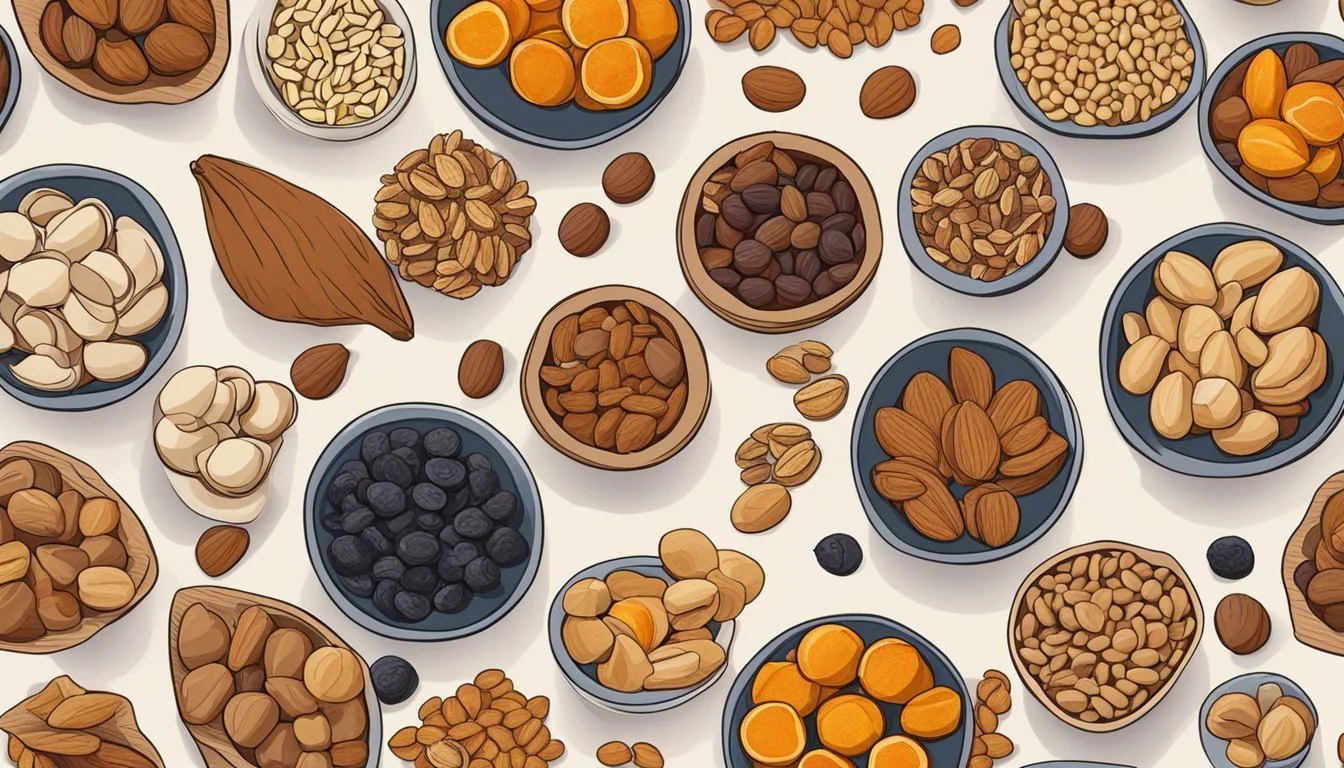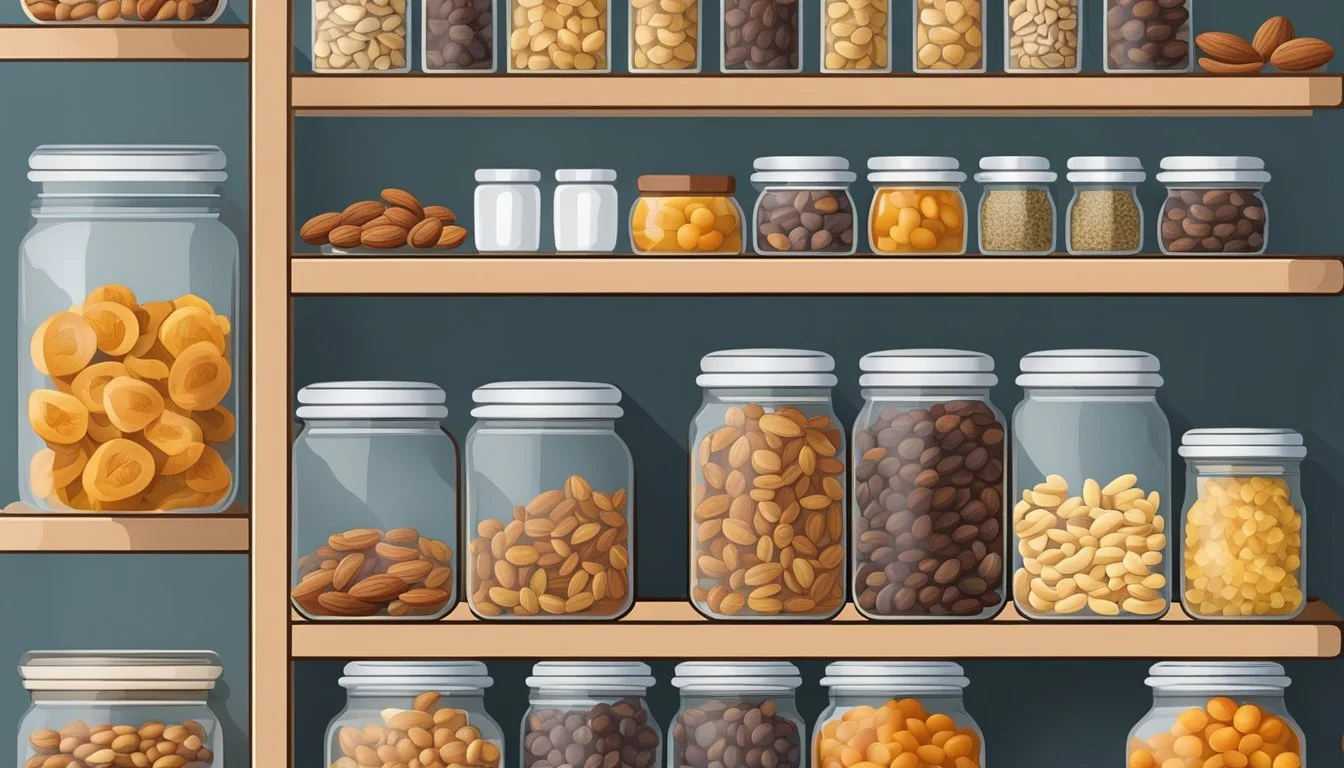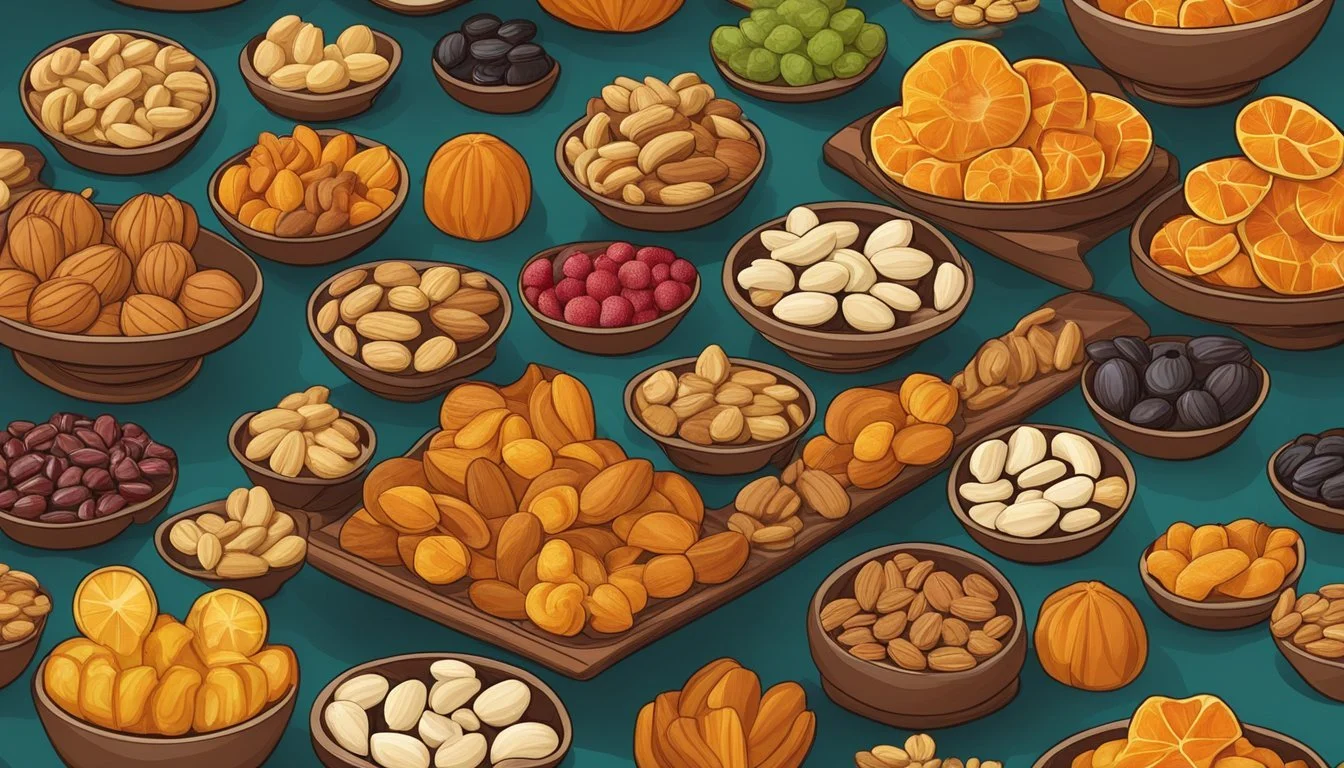Dried Fruit and Nut Recipes
Delicious Mixes for Healthy Snacking
Dried fruits (What wine goes well with dried fruits?) have been a staple in kitchens for centuries, offering a concentrated burst of sweetness and a longer shelf life than their fresh counterparts. Incorporating ingredients like dried dates, figs, currants, apricots, and raisins, they carry the essence of summer into heartier winter meals. From sweet to savory, dried fruit can be a versatile component in a variety of recipes, enhancing flavors and injecting a touch of natural sweetness into every dish.
The art of cooking with dried fruit is not only a nod to tradition but also a modern culinary trend that caters to a healthy lifestyle. Recipes often celebrate the combination of dried fruits with nuts, which provide a satisfying crunch and boost of nutrition. Nut loaves, for instance, intersperse the chewy texture of dried fruits with the rich, wholesome flavor of assorted nuts, creating a balanced and energy-packed meal option.
When venturing into the world of dried fruit recipes, precision in preparation is key. For instance, ensuring the oven is at the correct temperature is critical to achieving the desired outcome, whether it's baking a fruit and nut loaf or concocting homemade fruit-and-nut bars. These ingredients lend themselves to a myriad of culinary creations, from elaborate cakes to simple, rustic cookies, each promising a delightful combination of flavors and textures.
Essential Ingredients for Dried Fruit and Nut Recipes
When it comes to baking or preparing snacks that include dried fruits and nuts, selecting high-quality ingredients is crucial for the best flavor and texture. Both dried fruits and nuts come in a variety of options, each bringing its unique taste and benefits to a recipe.
Choosing Quality Dried Fruits
Dried fruits are the cornerstone of many recipes, offering concentrated flavors and natural sweetness. When selecting dried fruits, quality is essential. Raisins, currants, and prunes are commonly used for their sweet, tart flavors and are best when they are plump and glossy, free from excess oil or sugar coatings. Apricots should have a vibrant orange hue, indicating they have been dried properly and retain their nutrients. For a tangy twist, dried cherries are an excellent choice; make sure they are soft and not overly dry.
It is advisable to purchase dried fruits from a reputable grocery store or in bulk from trusted suppliers to ensure freshness. Below is a quick checklist for choosing high-quality dried fruits:
Raisins: Should be plump, dark or golden, without clumps.
Apricots: Bright orange, indicating minimal processing.
Dried Cherries: Soft, tangy, and free from artificial flavors or colors.
Prunes: Soft and sticky with a deep color, free from preservatives.
Currants: Dark, small, and tart, best when moist.
Varieties of Nuts and Their Uses
Nuts add a crunchy texture and rich flavor to dishes and can be used whole, sliced, chopped, or ground. Walnuts and pecans are known for their buttery flavors, which pair well with the sweetness of dried fruits in baked loaves or cookies. Almonds, available slivered or whole, work well in doughs and as toppings due to their firm texture and slightly sweet taste. Hazelnuts are another versatile option, offering a distinctive, robust flavor, especially when toasted.
Each nut has its unique characteristics that complement different types of dried fruits. Here's a guide to understanding their uses:
Nut Type Characteristics Common Pairings Walnuts Rich, buttery Raisins, apricots Pecans Buttery, sweet Prunes, dried cherries Almonds Firm, sweet Apricots, currants Hazelnuts Robust, rich Dried cherries, prunes
It is important to store nuts properly as they can become rancid due to their high oil content. They should be kept in a cool, dry place, or refrigerated to extend their freshness.
Baking Fundamentals
Baking with dried fruits and nuts requires precise knowledge of ingredients and their interactions. The right selection and proportion of flours, leaveners, fats, sweeteners, and eggs can yield delicious and textured outcomes.
Understanding Flours and Leaveners
Choosing flour is foundational in baking, as its gluten content determines the texture. All-purpose flour is versatile and commonly used for its moderate gluten level. For a heartier texture, whole wheat flour, which contains more nutrients, can be incorporated. Alternatively, bread flour has a higher gluten content, suitable for chewier loaves.
Leaveners like baking soda react with acidic ingredients to release carbon dioxide, creating lift in batters. Yeast, a living organism, ferments dough, contributing to both rise and flavor. It is vital to understand the correct quantity and conditions for each to function effectively.
The Role of Fats in Baking
Fats, including butter and oil, contribute to the moisture, richness, and flakiness of baked goods. Butter adds a distinct flavor and, when creamed with sugar, can trap air for a lighter texture. Oil is preferred in recipes for its ability to maintain moisture over time, ideal for fruit and nut loaf recipes that may be stored.
Sweeteners and Flavor Enhancers
Sweeteners do more than just sweeten; they add structure and moisture. Sugar is a common sweetener that, when creamed with fats, assists in leavening. Brown sugar and dark brown sugar contain molasses, contributing to a more complex flavor profile and chewiness due to added moisture. Honey can be a natural sweetener alternative, offering nuanced flavors and tender crumb in baked treats.
Flavor enhancers like spices and extracts complement the natural tastes of dried fruits and nuts.
The Importance of Eggs in Baking
Eggs are a crucial structural component, providing stability and moisture while also contributing to leavening. They bind ingredients together and can emulsify fats and liquids, creating a uniform texture. The protein in eggs coagulates when heated, which helps the baked good to set and maintain its shape.
Recipe Preparation Techniques
In preparing recipes that incorporate dried fruits and nuts, meticulous attention to dough and batter consistency, accurate shaping and proofing, as well as precise baking and cooling methods are crucial to achieving the desired flavor and texture in the finished product.
Mixing and Kneading Dough
The process begins in the mixing bowl, where dry ingredients like flour, baking soda, and salt are whisked together before the addition of wet ingredients. Dried fruits and nuts are folded into the batter after the initial ingredients are well combined. It's important to mix until the ingredients are just combined to avoid overworking the dough, which can result in a tough texture.
Shaping and Rising
Once the dough is mixed, it's shaped as required by the recipe—this could mean forming cookies, shaping bars, or assembling a loaf in a dutch oven. For breads that require a rise time, it is essential to allow them to rest in a warm, draft-free area. The dough should double in size, a process that typically takes one to two hours.
Baking and Cooling
The shaped dough is then transferred onto a parchment paper-lined baking tray or into a preheated dutch oven for baking. The oven temperature and time will vary based on the recipe, with items like cookies taking less time than denser fruit and nut loaves. After baking, items should be placed on a cooling rack to ensure even cooling, which prevents sogginess and helps maintain a crisp texture.
Classic Dried Fruit and Nut Recipes
The timeless appeal of dried fruit and nut recipes lies in their rich flavors and textural contrasts. Such recipes are not only a testament to culinary tradition but also a celebration of the comforting tastes of cinnamon and vanilla.
Fruit and Nut Breads
Fruit and Nut Bread is a cherished classic, where dried fruits such as dates, figs, and raisins are often combined with a variety of nuts to create a dense, moist loaf that is both nutritious and satisfying. The bread often incorporates cinnamon or vanilla extract, enhancing the flavor profile. Here's a simple breakdown of the ingredients usually found in a fruit and nut bread recipe:
Dry ingredients: Flour, baking powder, baking soda, and salt.
Spices: Cinnamon; sometimes nutmeg or allspice.
Wet ingredients: Eggs, vanilla extract, and sometimes buttermilk or yogurt.
Fruits and nuts: A mixture of dried fruits and chopped nuts, tailored to preference.
One can bake the bread at a lower temperature to ensure even cooking and moisture retention, typically around 300 degrees Fahrenheit (150 degrees Celsius).
Tarts and Pies
Moving from bread to the realm of pastry, dried fruits find their sweet spot in tarts and pies. The malleable texture of dried fruits such as apricots, currants, and raisins blends seamlessly into the buttery crusts of tarts and pies, often complemented by an assortment of nuts like walnuts or pecans.
To prepare a classic tart or pie:
Prepare the crust: This involves combining flour, butter, and a pinch of salt, then pressing the mixture into a tart pan and baking until golden.
Make the filling: Simmer dried fruits in a mixture of sugar and water until plump and tender; nuts and spices like cinnamon can be added at this stage.
Assemble and bake: Pour the fruit and nut mixture into the pre-baked crust, and bake until the filling is set.
These desserts are a true homage to the versatility of dried fruits and nuts, transforming simple ingredients into a sumptuous dessert that can be enjoyed year-round.
Innovative Recipes and Pairings
Dried fruits and nuts bring a dynamic flavor and texture to various recipes. By pairing them with chocolate or incorporating them into savory dishes, chefs can unlock a myriad of tastes and culinary possibilities.
Chocolate Infused Variations
Chocolate Chips and Dried Fruit Cookies: Bakers commonly enhance the classic chocolate chip cookie by adding dried fruits like cherries and apricots. They often use semi-sweet chocolate chips for a balance of sweetness, letting the fruit's tartness shine.
White Chocolate and Apricot Bars: Combining chopped dried apricots with melted white chocolate results in indulgent bars that juxtapose apricot’s tanginess against creamy chocolate.
Savory Dishes with Dried Fruits and Nuts
Stews: Dried fruits, such as dates or currants, are an excellent addition to stews, especially those that rest in the pantry waiting for the right moment. They bring a natural sweetness and thickness to the broth.
Pantry Pilaf: A savory fruit and nut basmati rice pilaf is a pantry staple that incorporates raisins and almonds for a textural contrast and a hint of sweetness amidst the savory spice of the dish.
Health and Dietary Considerations
When incorporating dried fruit and nut recipes into one's diet, it's crucial to take into account individual dietary needs and restrictions. This can range from allergen concerns to specific dietary requests that require gluten-free or vegan options.
Allergies and Substitutions
Those with nut allergies often need to exercise caution with fruit and nut bars. It's important to be patient and read labels or recipes carefully, as even traces of nuts can cause reactions. Substitutions such as seeds (like sunflower or pumpkin seeds) or soy nuts can be used as nut alternatives. They should consider the following:
Seeds: Alternative sources of nutrients and crunch.
Soy Nuts: Offering a similar texture to nuts without the risk.
For those allergic to specific fruits, alternative dried fruits that do not trigger any allergic response can typically be used without compromising the recipe's integrity.
Gluten-Free and Vegan Options
Recipes that call for ingredients like oats can sometimes include gluten, which is a concern for those with gluten sensitivities. They should look for certified gluten-free oats to ensure safety. Vegan individuals might need to substitute ingredients like honey with agave nectar or maple syrup to adhere to a vegan diet. When preparing dried fruit and nut recipes, consideration of gluten-free and vegan options might include:
Binding Agents: For vegan diets, chia seeds or flax seeds mixed with water can be a replacement for eggs.
Proteins: Gluten-free protein powders can supplement protein content for those on a vegan or gluten-free diet.
The recommended servings for such snacks will vary, but generally, moderation is key to maintaining a balanced diet.
Storing and Preserving Baked Goods
When it comes to storing baked goods that incorporate dried fruits and nuts, understanding the proper methods is key. This includes maintaining moisture levels and texture to ensure desserts with a dense or chewy quality remain enjoyable over time.
Maximizing Freshness
Storing baked goods effectively starts with understanding their moisture content. Items that are dense and chewy—like a fruitcake or date bars—require an airtight container to maintain their moisture. It’s crucial to let the baked goods cool completely before sealing them, as residual warmth can cause condensation, leading to sogginess or mold.
For short-term storage:
Place the baked goods in an airtight container.
Separate layers with parchment paper to prevent sticking.
Keep them at room temperature, away from direct sunlight.
For long-term freshness:
Consider wrapping individual portions in plastic wrap then sealing them in an airtight container.
Store in a cool, dry place to prevent the oils from the nuts from going rancid.
Freezing and Thawing Techniques
Freezing extends the life of baked goods significantly, preserving both their taste and texture.
Freezing Guidelines:
Ensure goods are completely cool to avoid ice crystals forming.
Wrap items tightly in plastic wrap or aluminum foil.
Place them in heavy-duty freezer bags or airtight containers.
Label with the date to track how long they have been frozen.
Thawing Directions:
Thaw baked goods in the refrigerator overnight, maintaining their chewy texture.
For items that benefit from warmth, unwrap and gently reheat in an oven set to a low temperature to restore their fresh-baked quality.
By following these specific storage and freezing techniques, one can keep their baked goods tasting freshly made for days or even months.
Decorating and Presentation
When it comes to decorating and presenting dried fruit and nut dishes, aesthetics are as important as flavor. One must consider the vibrant colors and the interplay with texture for a truly appealing presentation.
The Art of Garnishing
Garnishing with dried fruit and nuts can elevate the visual appeal of any baked goods. To create a professional and tempting look, bakers often use plump dried fruits such as apricots or figs for a touch of natural sweetness and a burst of color. Incorporating orange zest not only adds a vibrant hue but also infuses a subtle citrus flavor. A chef should gently press the dried fruit and nuts into the cake to adhere them, ensuring each piece is visible and attractive. A sprinkle of sea salt can also be used to enhance the flavor and create a delightful contrast in texture.
Serving Suggestions
The manner of serving is crucial; a flavorful loaf or cake should be sliced showing the colorful cross-section of dried fruits and nuts. For an extra elegant touch, one could brush the top with an apricot glaze for a glossy finish that emphasizes the textures. A well-presented plate might include thin slices of cake with a complementary sauce or cream, finished with a light dusting of powdered sugar. A creative server might choose to pair the dessert with a scoop of ice cream, allowing the creamy texture to contrast with the chewy and crunchy elements of the decorated dessert.
Advanced Baking Tips and Tricks
When seeking to elevate dried fruit and nut recipes, two crucial concepts are understanding the expert guidance provided by baking authorities like Alice Medrich and managing the temperatures of ingredients for optimal results.
Alice Medrich's Expert Advice
Alice Medrich, a renowned baking expert, emphasizes the importance of precision in both prep time and cook time. She advocates for the careful selection of spices to complement the natural flavors of the fruits and nuts. Medrich suggests that to maintain the integrity of a recipe's intended servings, one should not alter the ingredient proportions but instead ensure they are measured accurately.
Prep Time: Follow Medrich's instructions closely during preparation for better flavor and texture.
Cook Time: Monitor the oven and adjust cooking times as needed, as ovens may vary.
Optimizing Ingredient Temperatures
For the best results in baking with dried fruits and nuts, pay close attention to the temperature of key ingredients. Here's how:
Butter: Use it at room temperature unless the recipe states otherwise for optimal creaming.
Eggs: Room temperature eggs incorporate more easily into the batter, helping the final product to rise properly.
Dried fruits: Consider soaking them in warm water or juice before use to ensure they are tender.
By adhering to this targeted advice and managing temperatures carefully, one can achieve the sophisticated textures and rich flavors that characterize exceptional baked goods.





